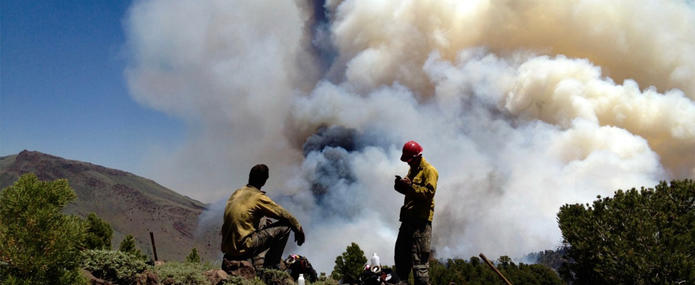Horrific fires have gripped large parts of Australia. These are a harbinger of the risks of climate change to even the wealthiest societies. According to the Australian Bureau of Meteorology, 2019 was Australia’s warmest year on record. National temperatures were 1.52° C above and national rainfall 40% below the long-term average. A record 5.2 million hectares have been burnt through in New South Wales alone, with the fire season only half way through. At least 25 people and hundreds of millions of animals have died, and a record amount of property destroyed. The human and economic impacts are already on important industries like farming, insurance and tourism is likely to be significant. The fires in Australia are 8 times larger than the 2019 fires in the Brazilian Amazon. The Brazilian fires caused international outrage, and even the threat of trade sanctions from French President Emmanuel Macron. Australians have glimpsed the future, and it isn’t is not pretty says Thomas Spencer, Associate Researcher at IDDRI, who is Australian and lives and works in India. In this context, wWhat are the prospects of a change in Australia’s climate policy?
The Federal Government claims that it is on track to reach the emissions target that Australia adopted under the Paris Climate Agreement. However, the Government’s own emissions projections are clear that Australia will still be short of its 2030 emissions target (see figure).
This is why Australia was one of the parties championing looser rules for emissions accounting at COP26 COP25 last year. The Government wants to use so-called ‘carry-over’ credits from the overachievement of its previous targets under the Kyoto Protocol in order to meet their its emissions targets under the Paris Agreement. Ultimately, this was one of the issues that caused the failure of COP25 to reach an agreement on this subject, as other parties refused to agree to weaker rules. Australia meeting its Paris agreement Agreement target is thus predicated on the use of past emissions allowances whose legality, from a compliance perspective, has not been approved by a decision of the parties to the Paris Agreement.
Some hope that the unprecedented fires, and the public concern they have created, would lead to a change in the position of the Australian Government.
In 2018, Australia was the second largest exporter of coal, and the fifth largest exporter of natural gas (and the second largest exporter of liquified natural gas, exports of which more than doubled between 2015 and 2018). Australia’s net exports of energy products equated to 3.7% of GDP in 2017, and almost a third of Australia’s total merchandise exports. Australia ranks 20th in terms of the share of fuel exports in total merchandise exports, ahead of Canada.
Despite energy exports’ role as an export earner, Australia’s is not a one trick economy. The share of fossil fuel extraction in GDP and employment was slightly higher than 5% and 0.7% in 2019. Australia is thus a diversified, flexible and extremely wealthy economy, and the vast majority of employment and economic activity occurs outside of the fossil fuel extraction sector.
On the other hand, big business does have an outside influence on the political and media landscape. Rupert Murdoch’s News Corp owns a substantial share of the print and TV media, and has generally prosecuted a climate sceptic line. In relation to the fires, News Corp editorials have peddled debunked claims that environmentalist restrictions on controlled, fire management burn-offs have led excessive fuel loads in Australia’s forests and hence caused the unprecedented severity of the fires.
In this environment, the electoral payoffs of a more progressive climate policy are not clear. After trailing in the polls for the preceding two years, .in 2019 the Liberal Party won the election with a policy of, for practical purposes, inaction on climate change. Australia followed the trend evident across most liberal democracies. The lower income, rural, working class vote has increasingly flowed to conservative parties. The vote of urban, upper income, cognitive class has increasingly flowed to left-of-centre parties. Thus, the Liberal won 23 of the 30 seats on offer in Queensland and 11 of the 16 seats in Western Australia, the two most resource-intensive states. That was enough to tip the balance.
It is the same trend that delivered working class Britain for Brexit and Boris. But whereas the British Conservative Party combines a hard-line position on Brexit with a progressive position on climate change, in Australia climate change is a prime casualty in the new culture war.
The forces that now haunt liberal democracy – —money in politics, media polarisation and banalization, cleavages between the globalist, urbaniszed cognitive class and the isolationist, often rural working class – —are now arrayed, for the moment, against climate action in Australia. The Government may make some cosmetic adjustments to its policies. But However it is hard to see significant change in the short -term.
But iIn the mid -term though, Australia must change. Climate change will wreak untold havoc on key industries like farming and tourism. The Australian landscape is extremely vulnerable: scientists fear that it may already be too late for to save large parts of the Great Barrier Reef. The past failure of Australia’s climate policy points the way forward. Progressives need to speak of climate change in terms of identity, heritage, and economic opportunity.
And indeed, there are huge opportunities for Australia, blessed with some of the world’s best renewable resources and highly innovative and flexible industries. A decarbonized world will need large quantities of resources, from lithium, cobalt, rare metals, to globally tradable synthetic fuels produced with renewable electricity. By 2050, the world could need 650 million tons of green hydrogen in a decarbonized scenario. That is a 1.95 trillion- dollar market. There is no reason why Australia can’t cannot thrive in a decarbonized world.
But as the fires show: it cannot thrive in a world of 3 degrees warming. That is for sure.


